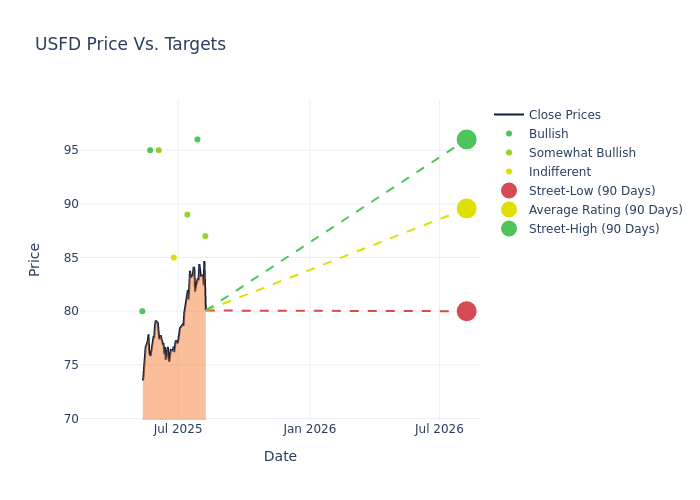
Throughout the last three months, 8 analysts have evaluated US Foods Hldg (NYSE:USFD), offering a diverse set of opinions from bullish to bearish.
The table below summarizes their recent ratings, showcasing the evolving sentiments within the past 30 days and comparing them to the preceding months.
| Bullish | Somewhat Bullish | Indifferent | Somewhat Bearish | Bearish | |
|---|---|---|---|---|---|
| Total Ratings | 3 | 3 | 2 | 0 | 0 |
| Last 30D | 0 | 1 | 0 | 0 | 0 |
| 1M Ago | 1 | 1 | 0 | 0 | 0 |
| 2M Ago | 0 | 0 | 1 | 0 | 0 |
| 3M Ago | 2 | 1 | 1 | 0 | 0 |
Analysts provide deeper insights through their assessments of 12-month price targets, revealing an average target of $88.62, a high estimate of $96.00, and a low estimate of $80.00. Witnessing a positive shift, the current average has risen by 9.8% from the previous average price target of $80.71.

Understanding Analyst Ratings: A Comprehensive Breakdown
The standing of US Foods Hldg among financial experts becomes clear with a thorough analysis of recent analyst actions. The summary below outlines key analysts, their recent evaluations, and adjustments to ratings and price targets.
| Analyst | Analyst Firm | Action Taken | Rating | Current Price Target | Prior Price Target |
|---|---|---|---|---|---|
| Edward Kelly | Wells Fargo | Raises | Overweight | $87.00 | $80.00 |
| Mark Carden | UBS | Raises | Buy | $96.00 | $84.00 |
| Brian Harbour | Morgan Stanley | Raises | Overweight | $89.00 | $84.00 |
| John Ivankoe | JP Morgan | Raises | Neutral | $85.00 | $82.00 |
| Jeffrey Bernstein | Barclays | Raises | Overweight | $95.00 | $85.00 |
| Karen Holthouse | Citigroup | Announces | Buy | $95.00 | - |
| John Ivankoe | JP Morgan | Raises | Neutral | $82.00 | $70.00 |
| John Heinbockel | Guggenheim | Maintains | Buy | $80.00 | $80.00 |
Key Insights:
- Action Taken: Responding to changing market dynamics and company performance, analysts update their recommendations. Whether they 'Maintain', 'Raise', or 'Lower' their stance, it signifies their response to recent developments related to US Foods Hldg. This offers insight into analysts' perspectives on the current state of the company.
- Rating: Gaining insights, analysts provide qualitative assessments, ranging from 'Outperform' to 'Underperform'. These ratings reflect expectations for the relative performance of US Foods Hldg compared to the broader market.
- Price Targets: Analysts predict movements in price targets, offering estimates for US Foods Hldg's future value. Examining the current and prior targets offers insights into analysts' evolving expectations.
Assessing these analyst evaluations alongside crucial financial indicators can provide a comprehensive overview of US Foods Hldg's market position. Stay informed and make well-judged decisions with the assistance of our Ratings Table.
Stay up to date on US Foods Hldg analyst ratings.
Get to Know US Foods Hldg Better
US Foods Holding Corp is the U.S. food service distributor that distributes food and nonfood products to the healthcare and hospitality industries, restaurants, and education, government facilities, and grocers. It has nearly 250,000 restaurants and foodservice operators with more than 70 locations that provide customers with food offering and a comprehensive suite of e-commerce, technology, and business solutions. The company operates in one business segment in which it markets, sells and distributes fresh, frozen and dry food and non-food products to foodservice customers throughout the U.S.
Financial Milestones: US Foods Hldg's Journey
Market Capitalization Analysis: The company's market capitalization is above the industry average, indicating that it is relatively larger in size compared to peers. This may suggest a higher level of investor confidence and market recognition.
Revenue Growth: US Foods Hldg's revenue growth over a period of 3M has been noteworthy. As of 31 March, 2025, the company achieved a revenue growth rate of approximately 4.49%. This indicates a substantial increase in the company's top-line earnings. As compared to competitors, the company encountered difficulties, with a growth rate lower than the average among peers in the Consumer Staples sector.
Net Margin: The company's net margin is a standout performer, exceeding industry averages. With an impressive net margin of 1.23%, the company showcases strong profitability and effective cost control.
Return on Equity (ROE): US Foods Hldg's ROE is below industry averages, indicating potential challenges in efficiently utilizing equity capital. With an ROE of 2.52%, the company may face hurdles in achieving optimal financial returns.
Return on Assets (ROA): US Foods Hldg's ROA stands out, surpassing industry averages. With an impressive ROA of 0.85%, the company demonstrates effective utilization of assets and strong financial performance.
Debt Management: US Foods Hldg's debt-to-equity ratio is below the industry average. With a ratio of 1.09, the company relies less on debt financing, maintaining a healthier balance between debt and equity, which can be viewed positively by investors.
The Significance of Analyst Ratings Explained
Analysts work in banking and financial systems and typically specialize in reporting for stocks or defined sectors. Analysts may attend company conference calls and meetings, research company financial statements, and communicate with insiders to publish "analyst ratings" for stocks. Analysts typically rate each stock once per quarter.
Some analysts publish their predictions for metrics such as growth estimates, earnings, and revenue to provide additional guidance with their ratings. When using analyst ratings, it is important to keep in mind that stock and sector analysts are also human and are only offering their opinions to investors.
Which Stocks Are Analysts Recommending Now?
Benzinga Edge gives you instant access to all major analyst upgrades, downgrades, and price targets. Sort by accuracy, upside potential, and more. Click here to stay ahead of the market.
This article was generated by Benzinga's automated content engine and reviewed by an editor.